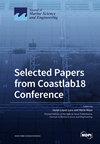Research on the Flow-Induced Vibration of Cylindrical Structures Using Lagrangian-Based Dynamic Mode Decomposition
IF 2.8
3区 地球科学
Q1 ENGINEERING, MARINE
引用次数: 0
Abstract
An oscillating flow past a structure represents a complex, high-dimensional, and nonlinear flow phenomenon, which can lead to the failure of structures due to material fatigue or constraint relaxation. In order to better understand flow-induced vibration (FIV) and coupled flow fields, a numerical simulation of a two-degrees-of-freedom FIV in a cylinder was conducted. Based on the Lagrangian-based dynamic mode decomposition (L-DMD) method, the vorticity field and motion characteristics of a cylinder were decomposed, reconstructed, and predicted. A comparison was made to the traditional Eulerian-based dynamic mode decomposition (E-DMD) method. The research results show that the first-order mode in the stable phase represents the mean flow field, showcasing the slander tail vortex structure during the vortex-shedding period and the average displacement in the in-line direction. The second mode predominantly captures the crossflow displacement, with a frequency of approximately 0.43 Hz, closely matching the corresponding frequency observed in the CFD results. The higher dominant modes mainly capture outward-spreading, smaller-scale vortex structures with detail displacement characteristics. The motion of the cylinder in the in-line direction was accompanied by symmetric vortex structures, while the motion of the cylinder in the crossflow direction was associated with anti-symmetric vortex structures. Additionally, crossflow displacement will cause a symmetrical vortex structure that spreads laterally along the axis behind the cylinder. Finally, when compared with E-DMD, the L-DMD method demonstrates a notable advantage in analyzing the nonlinear characteristics of FIV.利用基于拉格朗日的动态模式分解研究圆柱形结构的流致振动
流过结构的振荡气流是一种复杂、高维和非线性的流动现象,可能导致结构因材料疲劳或约束松弛而失效。为了更好地理解流动诱导振动(FIV)和耦合流场,我们对圆柱体中的二自由度 FIV 进行了数值模拟。根据基于拉格朗日的动态模态分解(L-DMD)方法,对圆柱体的涡流场和运动特性进行了分解、重建和预测。与传统的基于欧拉的动力模式分解(E-DMD)方法进行了比较。研究结果表明,稳定阶段的一阶模式代表了平均流场,展示了漩涡甩尾期的甩尾漩涡结构和在线方向的平均位移。二阶模主要捕捉横流位移,频率约为 0.43 赫兹,与 CFD 结果中观测到的相应频率非常接近。较高的主导模式主要捕捉向外扩展的、尺度较小的涡旋结构,具有详细的位移特征。气缸沿直线方向的运动伴随着对称的涡旋结构,而气缸沿横流方向的运动则与反对称涡旋结构有关。此外,横流位移会导致对称涡旋结构沿气缸后面的轴线横向扩散。最后,与 E-DMD 相比,L-DMD 方法在分析 FIV 的非线性特性方面具有明显优势。
本文章由计算机程序翻译,如有差异,请以英文原文为准。
求助全文
约1分钟内获得全文
求助全文
来源期刊

Journal of Marine Science and Engineering
Engineering-Ocean Engineering
CiteScore
4.40
自引率
20.70%
发文量
1640
审稿时长
18.09 days
期刊介绍:
Journal of Marine Science and Engineering (JMSE; ISSN 2077-1312) is an international, peer-reviewed open access journal which provides an advanced forum for studies related to marine science and engineering. It publishes reviews, research papers and communications. Our aim is to encourage scientists to publish their experimental and theoretical results in as much detail as possible. There is no restriction on the length of the papers. The full experimental details must be provided so that the results can be reproduced. Electronic files and software regarding the full details of the calculation or experimental procedure, if unable to be published in a normal way, can be deposited as supplementary electronic material.
 求助内容:
求助内容: 应助结果提醒方式:
应助结果提醒方式:


